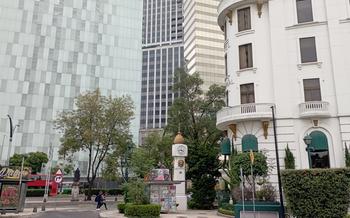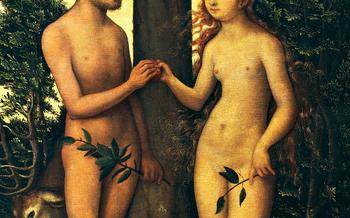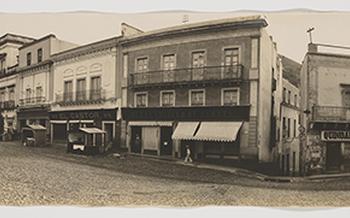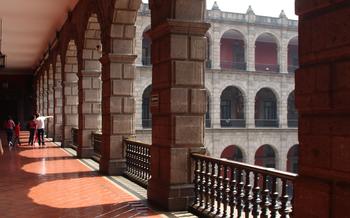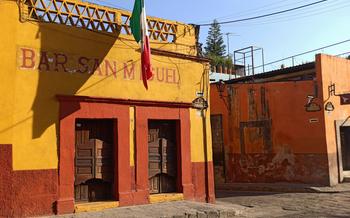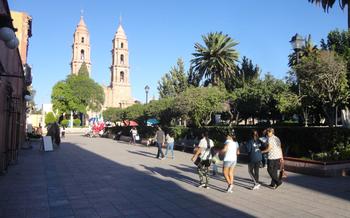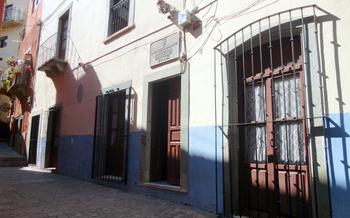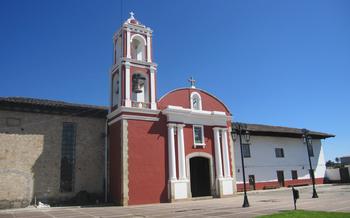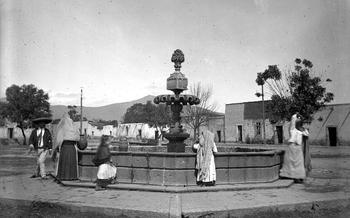
Callejón de la Concha
- The Callejón de la Concha: A Hidden Gem in Guanajuato
- History of the Alley
- Unique Architecture
- Cultural Significance
- Strolling the Callejón de la Concha
- Exploring the Museums
- The House of the Matamoros Family
- Lineage of Opulence
- Architectural Grandeur
- Contemporary Legacy
- The Teatro Cervantes
- The Legend of the Alley
- Shopping in the Callejón de la Concha
- Dining in the Callejón de la Concha
- The Callejón de la Concha at Night
- The Callejón de la Concha in Literature
- The Callejón de la Concha in Film
- The Callejón de la Concha in Music
- The Callejón de la Concha in Art
- The Callejón de la Concha for Kids
The Callejón de la Concha: A Hidden Gem in Guanajuato
Nestled in the heart of Guanajuato, a charming city renowned for its colonial architecture and vibrant culture, lies a hidden gem waiting to be discovered: the Callejón de la Concha. This narrow and picturesque alley, dating back to the 18th century, is a testament to the city's rich history and artistic heritage. With its unique architecture, cultural significance, and captivating legends, the Callejón de la Concha offers a mesmerizing experience for travelers seeking an authentic glimpse into the soul of Guanajuato.
History of the Alley
The Callejón de la Concha, meaning "Alley of the Shell," derives its name from the intricate seashell carvings that adorn the facade of the House of the Matamoros Family, one of the alley's most notable landmarks. Built in the late 18th century, the alley served as a vital thoroughfare connecting the city's main square, the Jardín de la Unión, with the bustling commercial district. Over the centuries, the Callejón de la Concha has witnessed countless historical events, evolving into a symbol of Guanajuato's enduring spirit and cultural legacy.
Unique Architecture
The Callejón de la Concha is renowned for its distinctive architectural style, a harmonious blend of colonial and neoclassical influences. The alley's narrow cobblestone path is flanked by a row of beautifully preserved buildings, each showcasing unique architectural elements. From the intricate wrought-iron balconies and colorful tile roofs to the elegant doorways and arched windows, every detail in the Callejón de la Concha speaks to the artistry and craftsmanship of its builders.
Cultural Significance
Beyond its architectural charm, the Callejón de la Concha holds immense cultural significance for the people of Guanajuato. The alley has been immortalized in local literature, art, and music, becoming an integral part of the city's cultural fabric. The alley's unique atmosphere and captivating history have also made it a popular setting for films, television shows, and theatrical performances, further cementing its status as a beloved cultural icon.
Strolling the Callejón de la Concha
The best time to visit the Callejón de la Concha is during the day, when the sunlight illuminates the colorful facades and creates a magical atmosphere. As you wander along the alley, you'll be greeted by friendly locals and street vendors selling traditional Mexican handicrafts and souvenirs. Take your time to explore the shops and galleries, and be sure to haggle for the best prices.
Along the alley, you'll find several museums and historical landmarks worth visiting. The Museo de la Alhóndiga de Granaditas, housed in a former granary, showcases the history of Guanajuato and the Mexican Independence War. The Museo Iconográfico del Quijote is a must-see for fans of the classic novel, featuring a collection of artwork and artifacts related to Don Quixote. And the Museo Casa Diego Rivera offers a glimpse into the life and work of the renowned Mexican muralist.
Don't forget to capture the perfect shot of the Callejón de la Concha. The alley's unique architecture and vibrant colors make for a stunning backdrop for your travel photos. Be sure to take some time to sit down at one of the cafes or restaurants and soak in the atmosphere of this enchanting place.
Exploring the Museums
The Callejón de la Concha boasts several notable museums that offer a glimpse into the rich history and culture of the region. The Museo de la Alhóndiga de Granaditas is a must-visit for history buffs. Housed in a former granary, the museum showcases exhibits on the Mexican War of Independence and houses a collection of historical artifacts, including weapons and documents.
The Museo Iconográfico del Quijote is a unique and quirky museum dedicated to the iconic literary character Don Quixote. Featuring a vast collection of artworks, sculptures, and interactive exhibits, the museum brings the adventures of the famous knight to life.
For those interested in art and Mexican culture, the Museo Casa Diego Rivera is a must-see. Located in the birthplace of the renowned muralist Diego Rivera, the museum houses a collection of his early works, as well as personal belongings and insights into his artistic process.
The House of the Matamoros Family
In the heart of the Callejón de la Concha stands a majestic edifice that whispers the tales of a prominent family - the House of the Matamoros Family. Built in the 18th century, this architectural marvel boasts a rich history that intertwines with the cultural tapestry of Guanajuato.
Lineage of Opulence
The Matamoros family, renowned for their immense wealth and influence, commissioned the construction of this grand residence. Their lineage can be traced back to the Spanish conquistadors who left an enduring mark on Mexico's colonial heritage. The Matamoros family played a pivotal role in shaping Guanajuato's economic and political landscape, leaving behind a legacy that continues to resonate within the city's walls.
Architectural Grandeur
The House of the Matamoros Family is a testament to the opulence and grandeur of its former occupants. Its intricate facade, adorned with finely carved stonework and wrought-iron balconies, evokes a sense of awe and admiration. The spacious interiors, adorned with opulent furnishings and elegant decor, reflect the family's refined taste and lavish lifestyle.
Contemporary Legacy
Today, the House of the Matamoros Family stands as a testament to the city's vibrant past. While the family no longer resides within its walls, the building has been repurposed as a cultural center, hosting exhibitions, workshops, and events that celebrate Guanajuato's rich history and vibrant artistic traditions.
The Teatro Cervantes
The Teatro Cervantes is one of the most iconic landmarks in the Callejón de la Concha. Built in the late 19th century, this beautiful theater is a testament to the rich cultural heritage of Guanajuato. Its striking neoclassical facade and ornate interior make it a must-visit for any visitor to the city.
The theater was originally built as a meeting place for the local elite, but it soon became a popular venue for theatrical performances. Over the years, it has hosted a wide range of productions, from traditional Spanish dramas to contemporary Mexican plays. Today, the Teatro Cervantes continues to be a vibrant cultural center, hosting a variety of performances throughout the year, including concerts, plays, and dance recitals.
Attending a show at the Teatro Cervantes is a truly magical experience. The theater's intimate setting and excellent acoustics make it the perfect place to enjoy a live performance. Whether you're a fan of classical music, theater, or dance, you're sure to find something to your liking at the Teatro Cervantes.
Practical Tips:
- Book your tickets in advance. The Teatro Cervantes is a popular venue, so it's a good idea to book your tickets in advance, especially if you're interested in seeing a popular show.
- Dress appropriately. The Teatro Cervantes is a formal venue, so it's important to dress appropriately. Jeans and a T-shirt are not acceptable attire.
- Arrive early. The Teatro Cervantes is a small theater, so it's a good idea to arrive early to get a good seat.
- Enjoy the show! The Teatro Cervantes is a beautiful theater with a rich history. Sit back, relax, and enjoy the show.
The Legend of the Alley
The Callejón de la Concha is steeped in a tragic love story that has become an integral part of local folklore.
Shopping in the Callejón de la Concha
The Callejón de la Concha is a treasure trove for shopping enthusiasts, offering a diverse range of local crafts, souvenirs, and unique items. Strolling through the alley, visitors will encounter numerous stalls and boutiques showcasing the talents of local artisans. From intricately embroidered textiles and colorful pottery to handcrafted jewelry and whimsical souvenirs, there's something to suit every taste and budget.
Art lovers will delight in the selection of galleries and boutiques featuring the works of local and international artists. From contemporary paintings and sculptures to traditional Mexican folk art, the Callejón de la Concha offers a vibrant and eclectic mix of artistic expression. Visitors can browse through the galleries, admire the diverse styles and techniques, and perhaps even take home a special piece to remember their visit.
When it comes to bargaining, the Callejón de la Concha presents an opportunity to engage in the friendly tradition of haggling. While prices are generally fair, visitors are encouraged to politely negotiate for a better deal, especially when purchasing multiple items. With a smile, a bit of patience, and a willingness to engage with the vendors, shoppers can often score great bargains.
Dining in the Callejón de la Concha
The Callejón de la Concha offers a diverse range of dining options, catering to various tastes and budgets. For those seeking a traditional Mexican culinary experience, the alley boasts several authentic restaurants serving up regional delicacies. From savory enchiladas and tacos to mouthwatering mole and pozole, there's something to satisfy every palate.
For those with a taste for international cuisine, the Callejón de la Concha also offers a variety of options. From Italian trattorias and French bistros to Japanese sushi bars and Indian curry houses, the alley provides a culinary journey around the world.
For those on the go or looking for a quick and affordable bite, the Callejón de la Concha offers a selection of street food stalls. These stalls offer a variety of local favorites, such as freshly made tortas, tacos, and quesadillas, all at budget-friendly prices.
When it comes to dining in the Callejón de la Concha, don't be afraid to venture off the beaten path and explore the hidden gems. Ask locals for recommendations, or simply follow your nose to discover some of the alley's best-kept culinary secrets.
The Callejón de la Concha at Night
As the sun sets, the Callejón de la Concha transforms into a vibrant and lively hub of activity. The alley's many restaurants and bars come to life, their tables spilling out onto the cobblestone streets, creating a convivial atmosphere. The air fills with the sounds of music, laughter, and the clinking of glasses. Local musicians often set up shop in the alley, serenading passersby with traditional Mexican songs.
The Callejón de la Concha is also a popular destination for cultural events and performances. Throughout the year, the alley hosts art exhibitions, concerts, dance performances, and theater productions. These events showcase the rich cultural heritage of Guanajuato and provide visitors with a unique opportunity to experience the city's vibrant arts scene.
While the Callejón de la Concha is generally safe, it is advisable to take precautions when exploring the alley at night. Be sure to stay aware of your surroundings, keep your valuables close, and avoid walking alone in isolated areas.
The Callejón de la Concha in Literature
The Callejón de la Concha has served as a source of inspiration for many literary works, both fiction and non-fiction. The alley's unique atmosphere and rich history have captured the imagination of writers from Mexico and beyond.
One of the most famous works inspired by the Callejón de la Concha is the novel "El callejón de los milagros" (The Alley of Miracles) by José Rubén Romero. Published in 1945, the novel tells the story of a group of people who live in the alley and their struggles for survival. The novel was a critical and commercial success and has been adapted into several films and television series.
Another notable work inspired by the alley is the poem "Callejón de la Concha" by Efraín Huerta. The poem describes the alley's beauty and its importance as a cultural symbol. Huerta's poem is one of the most famous poems about Guanajuato and is often recited at cultural events in the city.
In addition to novels and poems, the Callejón de la Concha has also been the subject of non-fiction works. These works include historical accounts of the alley, guidebooks, and travelogues. These works have helped to raise awareness of the alley's importance and have contributed to its growing popularity as a tourist destination.
The Callejón de la Concha continues to inspire writers today. Every year, new works of literature are published that draw on the alley's unique atmosphere and history. These works help to keep the alley alive in the public imagination and ensure that its legacy will continue for many years to come.
Literary events and festivals
The Callejón de la Concha is also a popular venue for literary events and festivals. Every year, the alley hosts the Callejón de la Concha Literary Festival, which features readings, workshops, and discussions with authors from around the world. The festival is a great opportunity to learn about Mexican literature and meet some of its most famous authors.
Bookstores and libraries
The Callejón de la Concha is also home to several bookstores and libraries. These stores offer a wide selection of books on Mexican literature, history, and culture. They are a great place to find souvenirs for your trip or to simply relax and enjoy a good book.
The Callejón de la Concha in Film
The Callejón de la Concha has served as a captivating backdrop for several films, both Mexican and international. Its unique architecture, rich history, and vibrant atmosphere have made it a popular choice for filmmakers seeking to capture the essence of Guanajuato.
One of the most notable films shot in the Callejón de la Concha is "El Santo contra las Momias de Guanajuato" (1972), a classic Mexican horror film starring the legendary luchador El Santo. The film features several scenes set in the alley, including a thrilling fight sequence between El Santo and the mummies.
Another notable film shot in the Callejón de la Concha is "Frida" (2002), a biopic about the life of Mexican artist Frida Kahlo. The film, which stars Salma Hayek as Kahlo, features several scenes shot in the alley, including a scene in which Kahlo is painting a mural on the wall of a building.
In recent years, the Callejón de la Concha has been featured in several international films, including "Spectre" (2015), the 24th installment in the James Bond film series. The film features a scene in which Bond, played by Daniel Craig, is chased through the alley by a group of henchmen.
The Callejón de la Concha is not only a popular filming location but also a major attraction for film buffs. Several film festivals and screenings are held in the alley throughout the year, showcasing a wide range of Mexican and international films. The alley is also home to several local cinemas, where visitors can catch the latest releases.
The Callejón de la Concha in Music
The Callejón de la Concha has inspired numerous musical compositions, from traditional Mexican ballads to contemporary pop songs. One of the most famous songs about the alley is "Callejón de la Concha" by Mexican singer-songwriter José Alfredo Jiménez. In his lyrics, Jiménez paints a vivid picture of the alley's charm, its cobblestone streets, and its colonial architecture.
The Callejón de la Concha is also a popular venue for musical performances. Every year, the alley hosts the Callejón de la Concha Music Festival, which features a diverse lineup of local and international musicians. The festival is a celebration of the alley's rich musical history and its vibrant cultural scene.
In addition to the music festival, the Callejón de la Concha is home to several music venues, including the Teatro Cervantes and the Casa de la Cultura. These venues host a variety of musical performances throughout the year, from classical concerts to rock shows.
Whether you're a fan of traditional Mexican music, contemporary pop, or anything in between, you're sure to find something to enjoy in the Callejón de la Concha. So come and experience the magic of this musical alley for yourself.
The Callejón de la Concha in Art
The Callejón de la Concha has been a source of inspiration for artists of all kinds for centuries. Many famous painters, sculptors, and photographers have captured the alley's unique beauty and atmosphere in their works.
One of the most famous paintings of the Callejón de la Concha is "La Calle de la Concha" by Diego Rivera. This painting, which hangs in the Museo de Frida Kahlo in Mexico City, depicts the alley in all its glory, with its colorful buildings, cobblestone streets, and lush vegetation.
Another famous painting of the Callejón de la Concha is "The Concha Alley" by José Clemente Orozco. This painting, which hangs in the Museo Nacional de Arte in Mexico City, depicts the alley in a more somber light, with its dark shadows and ominous atmosphere.
In addition to paintings, the Callejón de la Concha has also been the subject of numerous sculptures and photographs. One of the most famous sculptures of the alley is "The Concha Fountain" by Sebastián. This fountain, which is located in the Plaza de la Concha, depicts a group of children playing in the alley's fountain.
For many artists, the Callejón de la Concha is more than just a subject matter; it is a place of inspiration and creativity. The alley's unique beauty and atmosphere have helped to create some of the most famous works of art in Mexico.
The Callejón de la Concha for Kids
The Callejón de la Concha is not just a place for adults to enjoy; it also offers plenty of attractions for children. Families can spend a delightful day exploring the alley's interactive museums and workshops, which provide hands-on experiences that will keep the little ones engaged and entertained. From learning about history and science to creating their own crafts and artwork, there's something for every child to enjoy.
One of the highlights for kids is the Museo del Juguete, a toy museum that showcases a vast collection of traditional Mexican toys. Here, children can admire the intricate craftsmanship of these handmade treasures and even try their hand at making their own toys in the museum's workshop.
Another popular spot for families is the Museo de la Alhóndiga de Granaditas, which offers interactive exhibits on the history of the city and the region. Kids can learn about the mining industry that shaped Guanajuato's past and even experience what it was like to work in a mine through a virtual reality simulation.
After a day of exploring the museums, families can refuel at one of the many kid-friendly restaurants in the Callejón de la Concha. From traditional Mexican cuisine to international favorites, there's something to satisfy every palate. And for a sweet treat, don't miss the delicious ice cream shops and churrerías that line the alley.
Whether you're traveling with toddlers or teenagers, the Callejón de la Concha has something to offer everyone in the family. So, make sure to add this charming alley to your itinerary for a memorable and enriching experience in Guanajuato.
